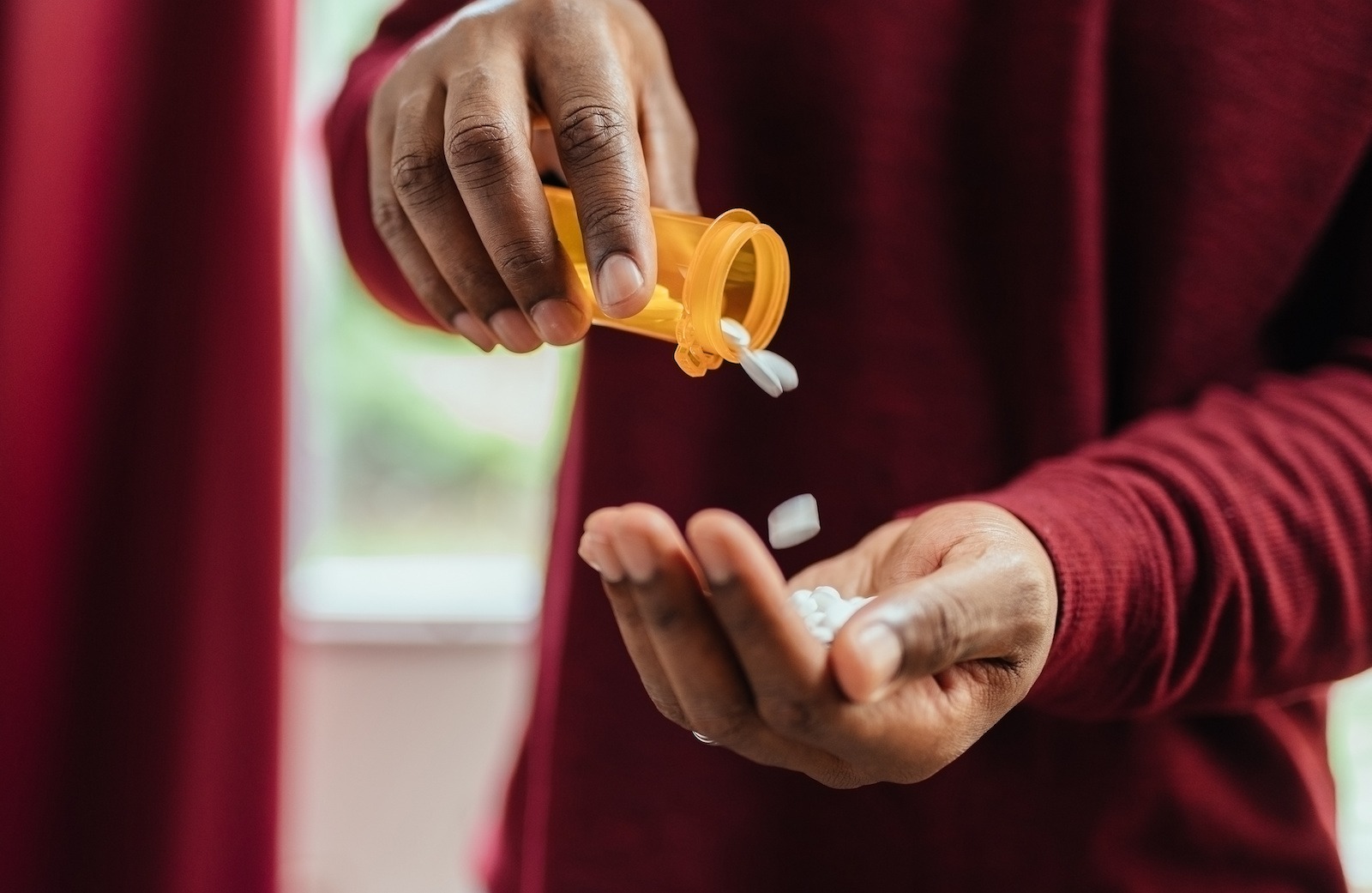Addiction | 6 min read
Vicodin Addiction: The Dangerous Cycle Of Addiction & How To Get Out Of It
Medically Reviewed By

On August 26, 2022
Written By
On August 20, 2022

Vicodin is one of the most common pain medicines prescribed for severe pain. Post-surgical pain, back injuries, broken bones, and chronic health conditions and injuries are all reasons you might be given a Vicodin prescription.
Let’s talk about Vicodin addiction, how you can tell if you or a loved one are starting to develop a Vicodin dependence or addiction, the side effects of substance abuse and withdrawal, and what you can do to get help.
This article is designed to be helpful whether you’re looking for information for yourself or someone else, so even if you aren’t addicted, this article can still be a good resource to help you understand more about Vicodin abuse.
What is Vicodin?
Vicodin is a prescription drug that is a combination medication with two different painkillers included in each pill. It’s made with hydrocodone, a narcotic analgesic, and acetaminophen (Tylenol), a non-aspirin pain reliever that is also not an NSAID. Both medications can be powerful tools for controlling severe pain, breaking through pain barriers, and letting patients regain their previous quality of life while dealing with pain.
The danger of this drug combination is that hydrocodone, the opioid included in Vicodin, comes with a risk of developing an addiction, especially with long-term use.
Acetaminophen is non-addictive and safe to use, but it can come with some nasty side effects, including liver damage when taken in large doses or for longer than recommended. This can mean that people who get addicted to Vicodin may have additional side effects and health complications compared with people who are addicted to a narcotic medication without acetaminophen.
People who abuse Vicodin are also more likely to get a too-large dose of acetaminophen, which may mean that health complications will happen more quickly and can become more severe than addiction to other pain medications.
The good news is that there are resources that can help if you develop a dependence on Vicodin during normal use of the medication. In addition, some resources can help if dependence turns into a full-blown addiction, even if you’ve started taking other medications and drugs in addition to Vicodin.
What Does Vicodin Addiction Look Like?
One of the challenges of recognizing addiction to Vicodin is that the addiction often starts with a legitimate prescription from a healthcare provider. Both the medication and the kinds of extreme pain that Vicodin is used to control can make someone seem tired, irritable, or out of it.
Severe pain can sometimes look like a change in personality from the outside. That means it can sometimes be hard to tell the difference between legitimate use of Vicodin for pain and Vicodin abuse due to its narcotic high.
Another important factor is that your body can develop Vicodin dependence relatively quickly. Some people only take about 5-7 days to develop dependence.
Remember, dependence and addiction aren’t the same things. Physical dependence develops because of changes in your body’s production of natural chemicals and neurotransmitters because of a medication.
Addiction can involve dependence but also includes a psychological need for the drug and is generally more controlling and distressing than dependence. This means that the difference between responsible Vicodin use and addiction can be very slim and that people prone to addictive behavior may develop an addiction to Vicodin very quickly.
Symptoms of Vicodin Addiction
Signs of Vicodin addiction include:
- Reduced Heart Rate
- Anxiety
- Rapid weight changes
- Depression
- Insomnia or excessive sleeping
- Constipation
- Frequent headaches
- Migraines
- Frequent dizziness
- Nasal congestion
In severe cases, or in cases where you’ve taken too much Vicodin at once, you may also experience more serious side effects, including:
- Seizures
- Coma
- Difficulty breathing
- Struggling to form words or communicate clearly.
In addition, because any medication with acetaminophen can risk liver damage, you should also watch out for signs of liver problems, including:
- Swollen Legs
- Swollen Abdomen
- Jaundice (yellowing of the skin and eyes)
- Excessive sweating
- Nausea
- Vomiting
- Stomach cramps
- Fatigue
These signs and symptoms may indicate a problem or that someone is taking too much medication to be safe. Excessive use of Vicodin may result from addiction, being in more pain than Vicodin can control, or having a lower tolerance for the two active ingredients in Vicodin.
What to Do if You Have Symptoms of Vicodin Addiction
If you are worried that you are addicted to Vicodin or that a loved one may be addicted, it’s also worth considering the psychological signs of addiction, including:
- Experiencing cravings for the drug or feeling like you need the Vicodin to be okay (for reasons other than pain)
- Feeling sick or getting headaches between doses
- Worrying about how much Vicodin you have
- Worrying that you won’t be able to get more Vicodin when you run out
- Considering buying Vicodin online, especially if you’re also considering buying Vicodin without a prescription
- You feel like you need to take Vicodin to be able to handle social situations
The trick here is that, like any pain medication, the symptoms of wanting to get out of pain can be similar to an addiction. Both are stressful and can make you worry about your supply of Vicodin and hope you can get more.
It’s a good idea to talk with your doctor about concrete signs of addiction if you’re worried and consider if alternative pain control medications and techniques might be a better option.
Side-Effects Of Vicodin Addiction & Withdrawal Symptoms When Detoxing
Vicodin addiction is a serious problem and isn’t easily fixed. Especially in cases where you need to manage your addiction and pre-existing pain, there can be challenges, and it can be difficult to find the right balance between treating pain and drug abuse.
Remember, you don’t need to go through this alone.
Knowing what to expect when withdrawing from Vicodin can help you manage your symptoms and feel better. It’s a good idea to familiarize yourself with the most common symptoms and get outside support from someone who knows the symptoms, warning signs, and best management techniques for Vicodin withdrawal.
Withdrawal from any drug is difficult, so prepare with comfort items, good support systems, good nutrition, and hydration heading into withdrawal and detox.
Here’s what you can expect from withdrawal after Vicodin addiction:
- Insomnia
- Anxiety
- Sweating
- Chills / hot flashes
- Muscle aches
- Excessive yawning or drowsiness
- Runny nose / postnasal drip
You may also get a sore throat if you get a runny nose or postnasal drip. However, this symptom is not due to Vicodin withdrawal itself and is instead due to postnasal drip.
Depending on how long you’ve been addicted to Vicodin, how much you or your loved one was taking, and how dependent your body is on the drug, it can take anywhere from a few days to several weeks for withdrawal symptoms to clear. Some users report sudden withdrawal symptoms for several months after their last Vicodin dose. However, that’s more common in people with severe and long-lasting substance use disorders than people whose addiction was shorter or who took smaller doses of the drug.
How To Get Help For A Vicodin Addiction
Getting help for Vicodin addiction can seem like a big step, and it’s alright if it’s a little intimidating at first. Remember that you can do this and don’t have to do it alone.
The first step in getting help for any addiction is admitting that you need help and deciding that you want to see what life can be like without addiction.
Once you’ve committed to overcoming addiction, the next step is researching and reaching out for support. If you’re reading this article, you’re already starting that step. Congratulations!
It’s also a good idea to talk with your primary care doctor if you have one and to ask about local resources to help you overcome addiction in your area. They might be able to recommend a wide variety of potential programs, ranging from individual therapy to inpatient care in a treatment center specializing in addiction and mental health treatment.
The right treatment will be a little different for everyone, but you should try to match the level of treatment you choose to the severity of the addiction you’re dealing with. If your Vicodin addiction has been going on for a long time, or if you need to take larger doses to get the same relief you used to, you might need a more intensive addiction treatment program.
If you’ve only recently become addicted to Vicodin, take a relatively small dose, and normally lead a healthy and happy life, you might not need as much support to overcome addiction.
No matter what kind of treatment you decide on, remind yourself that there’s no shame in seeking help. Some people need in-patient treatment to overcome addiction, and that’s okay! You don’t need to try to do this on your own. In many ways, it’s stronger to admit that you need extra help and are willing to commit to your health by overcoming addiction.
Once you know what kind of treatment you want, it’s time to start thinking about the different treatment programs and providers in your area. Research each provider, look at their techniques and galleries, and find out what (if any) insurance providers they accept to start narrowing down your choices.
The right treatment center can improve your chances of successfully overcoming prescription drug addiction.
Looking For Vicodin Addiction Treatment in New York?
If you’re ready to overcome addiction and lead a happier, healthier lifestyle, Ascendant NY may be able to help.
Reach out to us to schedule an intake, ask questions about our programs, or learn more about addiction recovery and how it works. We’re always happy to answer questions about our programs.
Ascendant New York Editorial Guidelines
Here at Ascendant New York, we understand the importance of having access to accurate medical information you can trust, especially when you or a loved one is suffering from addiction. Find out more on our policy.
- Mayo Clinic. Hydrocodone And Acetaminophen (Oral Route) Description and Brand Names – Mayo Clinic. Accessed August 11, 2022. https://www.mayoclinic.org/drugs-supplements/hydrocodone-and-acetaminophen-oral-route/description/drg-20074089
- Meades J. New discovery: how chronic pain changes your brain and personality. NeuRA. Published December 4, 2019. Accessed August 11, 2022. https://neura.edu.au/news-media/media-releases/new-discovery-how-chronic-pain-changes-your-brain-and-personality/
- Lee D. Tylenol Liver Damage: Signs, Symptoms, Dosages, Overdose & Treatment. MedicineNet. Published May 16, 2022. Accessed August 11, 2022. https://www.medicinenet.com/tylenol_liver_damage/article.htm





